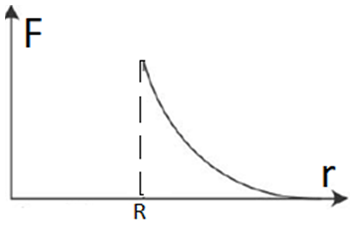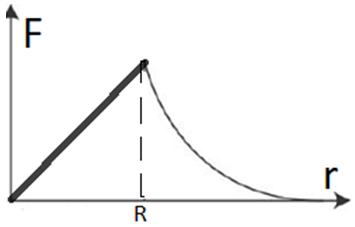This set of Class 11 Physics Chapter 8 Multiple Choice Questions & Answers (MCQs) focuses on “Gravitation”. These MCQs are created based on the latest CBSE syllabus and the NCERT curriculum, offering valuable assistance for exam preparation.
1. For which of the following does the graph denote the variation of force of gravity “F” along a distance “r”?

a) Solid sphere
b) Spherical shell
c) Plate
d) Point
View Answer
Explanation: The force of gravity is zero withing a spherical shell and varies similar to a point source at a distance greater than or equal to its radius.
2. For which of the following does the graph denote the variation of force of gravity “F” along a distance “r”?

a) Solid sphere
b) Spherical shell
c) Plate
d) Point
View Answer
Explanation: The gravitational force is proportional to distance “r” until r=radius. For values of “r” greater than the radius of the sphere, the force is inversely proportional to the square of the distance.
3. What is the gravitational force experienced by an object of 10kg 200m away from an object weighing 1 ton?
a) 1.6675 N
b) 2.6675 N
c) 3.6675 N
d) 4.6675 N
View Answer
Explanation: From Newton’s law of gravitation, we have;
F = (G*M1*M2*)/R2
G = 6.67 x 10-11 N m2/kg2
M1 = 10kg
M2 = 1000kg
R = 200m
F = (6.67 x 10-11 x 10 x 1000) / 2002
= 1.6675 N.
4. Which scientist introduced the universal law of gravitation?
a) Albert Einstein
b) Isaac Newton
c) Stephen Hawking
d) Nikola Tesla
View Answer
Explanation: The universal law of gravitation is a part of Isaac Newton’s work “Philosophiæ Naturalis Principia Mathematica (the Principia)”, first published on 5 July 1687.
5. What will be the value of acceleration due to gravity on the surface of the earth if the radius of the earth suddenly decreases to 60% of its present value, keeping the mass of the earth unchanged?
a) 9.81 m/s2
b) 5.89 m/s2
c) 16.35 m/s2
d) 27.25 m/s2
View Answer
Explanation: From Newton’s law of gravitation, we have;
g = (G*M1)/R2
Since the radius is reduced to 60% of its original value;
The new radius R’ = 0.6 x R
Therefore;
g’ = (G*M1)/(0.6*R) 2
g’ = g/(0.6) 2
= 9.81 / (0.6 x 0.6)
g’ = 27.25 m/s2.
6. The value of acceleration due to gravity of earth at the equator is less than that of the poles due to _____
a) shape and rotation of the earth
b) mass of the sun
c) mass of the earth
d) mass of the moon
View Answer
Explanation: The gravitational force is a central force. Acceleration due to gravity has different values for different points on the earth’s surface.
7. The weight of an object can be zero but the mass of an object can never be zero.
a) True
b) False
View Answer
Explanation: The weight of an object is zero when the net gravitational force acting on the object is zero. However, the mass of an object can never be zero since mass is a property of matter.
8. Gravitational force is the strongest fundamental force.
a) True
b) False
View Answer
Explanation: Gravitational force is the weakest fundamental force. The strong nuclear force is the strongest fundamental force of nature.
9. Gravitational force is _____
a) an imaginary force
b) a long-range force
c) a short-range force
d) the strongest fundamental force
View Answer
Explanation: Gravitational force is a long-range force which is inversely proportional to the square of the distance. The strong nuclear force is the strongest fundamental force and is a short-range force.
10. The universal law of gravitation becomes more inapplicable as the size and distance between objects decreases.
a) True
b) False
View Answer
Explanation: As the size and distance between objects decrease, nuclear forces become stronger and the law of gravitation cannot be applied. This calls for a new branch of physics known as “quantum physics”.
11. What is the force of gravity experienced by an object at the centre of the earth? (Assume that the earth is perfectly spherical)
a) 0 g-force
b) 1 g-force
c) 9.81 g-force
d) 10 g-force
View Answer
Explanation: Since a body at the centre of the earth would experience equal gravitational force from all sides, the vector addition of all of these forces amount to zero. Therefore, the force experienced by an object at the centre of the earth is zero.
More MCQs on Class 11 Physics Chapter 8:
- Chapter 8 – Gravitation MCQ (Set 2)
- Chapter 8 – Gravitation MCQ (Set 3)
- Chapter 8 – Gravitation MCQ (Set 4)
- Chapter 8 – Gravitation MCQ (Set 5)
- Chapter 8 – Gravitation MCQ (Set 6)
- Chapter 8 – Gravitation MCQ (Set 7)
- Chapter 8 – Gravitation MCQ (Set 8)
- Chapter 8 – Gravitation MCQ (Set 9)
- Chapter 8 – Gravitation MCQ (Set 10)
- Chapter 8 – Gravitation MCQ (Set 11)
- Chapter 8 – Gravitation MCQ (Set 12)
To practice all chapters and topics of class 11 Physics, here is complete set of 1000+ Multiple Choice Questions and Answers.
If you find a mistake in question / option / answer, kindly take a screenshot and email to [email protected]
- Practice Class 11 - Chemistry MCQs
- Practice Class 11 - Mathematics MCQs
- Practice Class 12 - Physics MCQs
- Practice Class 11 - Biology MCQs
- Check Class 11 - Physics Books
